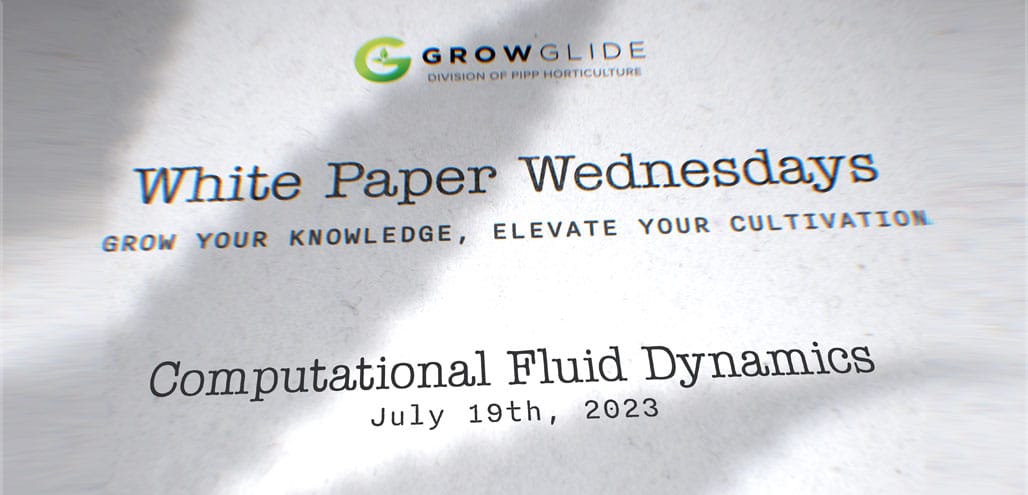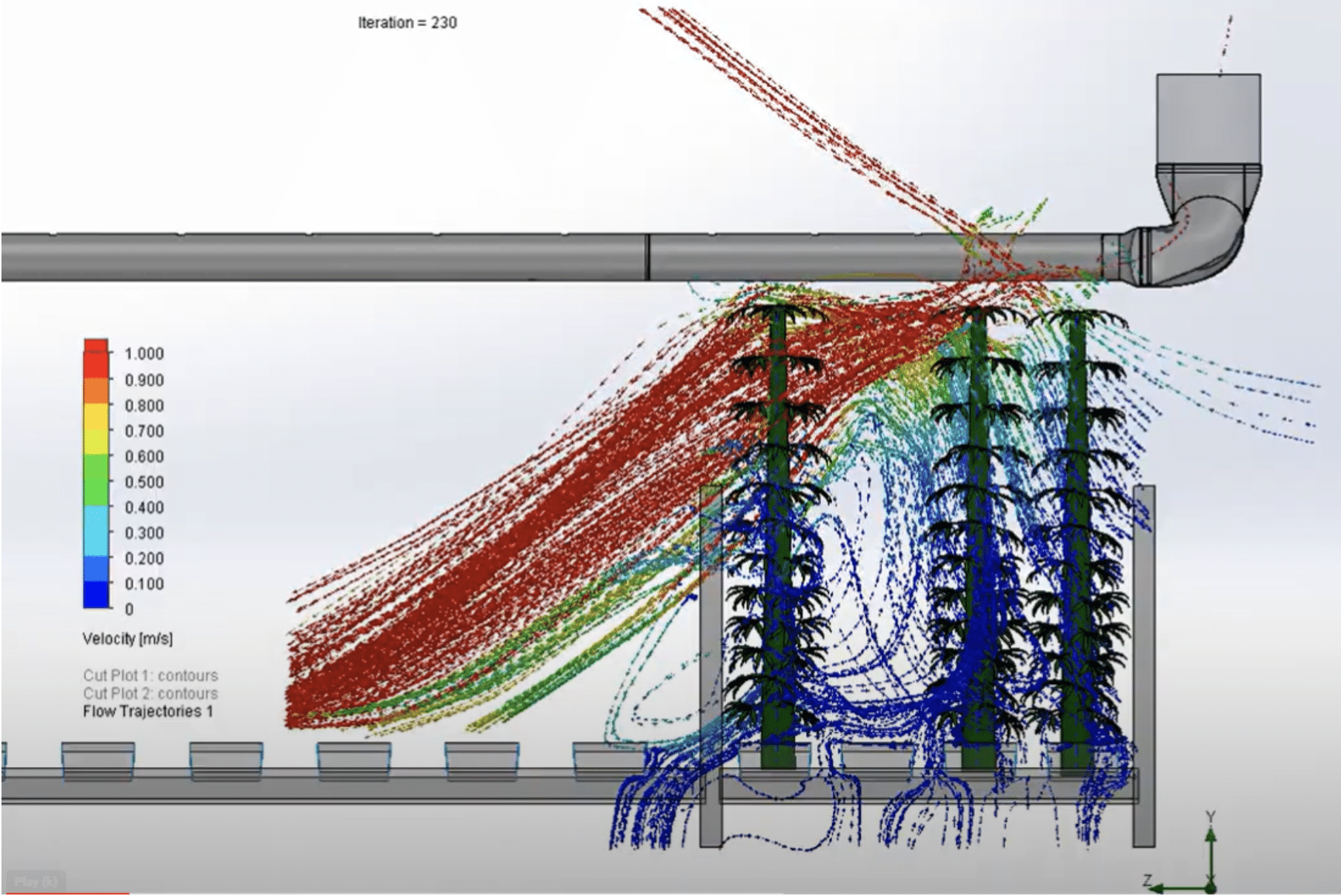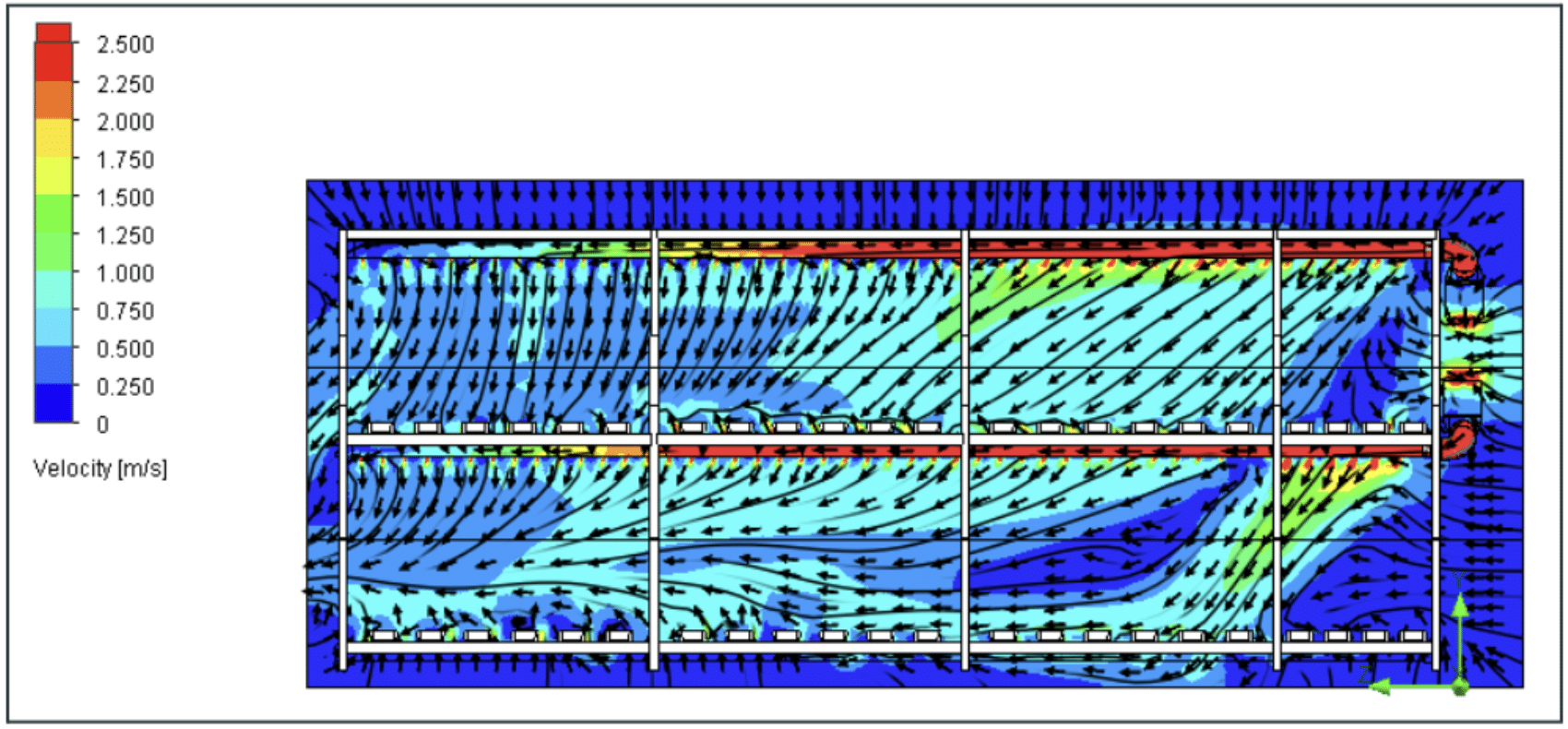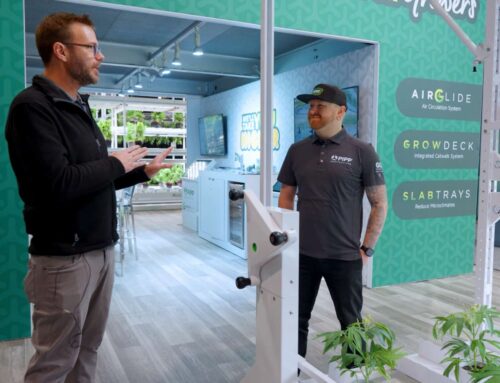
What Is CFD Modeling?
CFD modeling, or Computational Fluid Dynamics modeling, is the simulation and analysis of the behavior of fluids (such as air or water) and their interactions with objects or environments, like cannabis plants, lighting, and racks. It involves creating a virtual representation of a real-world system and using mathematical equations to predict how the fluid flows, how heat transfers within it, and how other properties change.
What about when we apply it to cannabis cultivation? As a simple example, imagine you have a cannabis cultivation facility. CFD modeling would allow you to create a computerized simulation of the growing environment, the air inside it, and how the air moves when the ventilation system is on. You can study factors like temperature distribution, airflow patterns, and how well the plants receive conditioned CO2-rich air. By manipulating different variables, you can test scenarios to optimize your design and improve the efficiency or performance of the ventilation system and augmented airflow solutions.
(CFD Model Created by Grow Glide)
CFD modeling uses complex mathematical equations to calculate and predict fluid behavior based on factors like fluid properties, object shapes, and environmental conditions. It helps researchers, engineers, and scientists understand and analyze fluid flow phenomena without the need for costly and time-consuming physical experiments. In some ways, this is a great bridge between engineers trying to design facilities and cultivators collecting the real-world experiences and obstacles needed to guide the study.
Overall, CFD modeling provides a virtual laboratory where cultivators can explore and study the behavior of fluids in various applications, including agriculture, helping to optimize designs, improve performance, and understand complex fluid dynamics.
But it does not replace actual cultivation experience. Just because a model looks sexy doesn’t mean it will produce results that drive the goals of a cannabis cultivation business. That is why it is important to understand the limitations and opportunities CFD modeling presents.
Positives of CFD Modeling for Agriculture
The use of CFD modeling in agriculture is revolutionizing how growers understand and manage their cultivation environments. Here are some of the top advantages of employing CFD modeling in agricultural practices.
- Improved Understanding: CFD modeling provides a deeper understanding of fluid flow patterns, heat transfer, and mass transfer within agricultural systems. This understanding can help optimize various processes, such as irrigation, ventilation, and pesticide application, improving crop growth and yield.
- Design and Optimization: CFD modeling allows for the design and optimization of agricultural structures and equipment. For example, it can be used to optimize cultivation and curing facility designs, and irrigation systems, to ensure efficient use of resources, such as water and energy, and create optimal growing conditions.
- Cost and Time Savings: By using CFD simulations, cultivators, entrepreneurs, and engineers can save costs and time that would otherwise be spent on physical experiments and field trials. Virtual simulations enable them to explore different scenarios, test multiple designs and evaluate various parameters without the need for costly prototypes or extensive field testing.
- Environmental Impact Assessment: CFD modeling can aid in assessing and minimizing the environmental impact of cultivation practices. It can simulate the dispersion of airborne pollutants, such as pesticides or odors, helping to optimize application methods and reduce their negative effects on surrounding ecosystems and human health — and help cultivation facilities be better neighbors.
Negatives of CFD Modeling for Agriculture
While the application of CFD modeling in agriculture, particularly in cannabis cultivation, has provided numerous advantages, it is crucial to understand that it is not without its challenges and limitations.
- Complex Modeling Process: CFD modeling requires a high level of expertise and computational resources. Developing accurate models and setting up simulations can be complex and time-consuming, requiring specialized software, hardware, and cannabis intimacy. Oftentimes, those fluent in Autodesk or Solidworks are not fluent in Crop Steering or Phenotypic expression, and vice versa.
- Model Validation Challenges: Validating CFD models for cannabis can be challenging due to the inherent complexity and variability of cultivating dynamic cultivars that grow quickly. Obtaining accurate input data, such as leaf area index, transpiration rates, or media characteristics, can be difficult. Ensuring the model’s accuracy and reliability requires extensive experimental data and validation efforts.
- Simplifications and Assumptions: CFD models often use simplifications and assumptions to represent complex cultivation systems and interactions. While these simplifications are necessary to make the simulations computationally feasible, they can introduce uncertainties and limitations to the results. Careful consideration and validation of the assumptions are crucial to ensure the model’s reliability.
- Integration with Real-world Systems: Translating the findings and recommendations from CFD simulations into practical applications in the field can be a challenge. Real-world cannabis cultivation has additional complexities and constraints that need to be considered, such as equipment limitations, operational constraints, SOP impacts, or economic factors. Integration with existing agricultural practices requires careful evaluation and adaptation.
Overall, CFD modeling holds great potential for optimizing and improving agricultural processes. However, it is essential to acknowledge the limitations and challenges associated with its implementation and ensure that the models are properly validated and integrated into real-world agricultural systems.
CFD Benefits for Cannabis Racking Systems
(CFD Model Created by Grow Glide)
Some isolated applications of CDF modeling have led to product development, validation and financial impact in cannabis cultivation and curing.
- Airflow Optimization: CFD modeling allows for the optimization of airflow patterns within multitier cultivation racking systems. It helps analyze air distribution and identify areas of poor ventilation or stagnant zones. By simulating different airflow configurations, designers can determine the most efficient setup for delivering conditioned CO2 to plants and removing excess heat and humidity. This optimization enhances air circulation and ensures uniform environmental conditions throughout the cultivation racks — and is precisely how Grow Glide developed the AirGlide solution available today.
- Temperature and Humidity Control: Maintaining optimal temperature and humidity levels is crucial for plant growth and VPD management in multitier cultivation racking systems. CFD modeling enables the system to analyze heat transfer and humidity distribution. By simulating different scenarios, it helps identify potential hotspots, areas of high humidity or regions with temperature variations. This information can be used to design efficient ventilation, cooling, and humidification systems, as well as indicate the most appropriate locations for sensors and interpret the accuracy of data collection.
- Light Distribution: Light is a critical factor in plant growth, particularly in indoor cultivation, and CFD modeling can illustrate heat generation from lights and environmental factors that will influence lighting performance. By considering factors like reflective surfaces, positioning of lights, distance from the plants, planting density, and leaf area index, the model can help optimize the light distribution and guide the most efficient production techniques. This ensures that plants receive adequate and uniform light levels, promoting healthy growth and optimizing photosynthesis.
- Optimization of Resource Utilization: CFD modeling can assist in optimizing resource utilization by simulating the airflow and environmental conditions, it helps identify areas of excessive air movement or areas where resources are being wasted. This information can be used to adjust irrigation strategies, nutrient delivery systems, planting densities, environmental conditions, and airflow strategies that drive efficient resource utilization and minimize wastage while optimizing phenotypic expression.
- Pest and Disease Management: CFD modeling can aid in pest and disease management in multitier cultivation racking systems in several ways. By analyzing airflow patterns, it helps identify areas where pests or pathogens may accumulate and how applications flow through the room. CFD modeling can also demonstrate the most effective application strategies for IPM/IMM applications. Some examples are determining the best droplet size, application rates, and application techniques that aid in refining SOPs and efficacy.
- Design and Scale-Up: CFD modeling enables engineers and architects to simulate different configurations, test the impact of variables like rack spacing, plant density, or system layout, and optimize the design for maximum productivity and resource efficiency. This helps streamline the cultivation process and improve the overall performance of the system.
CFD modeling offers valuable insights into airflow, temperature, humidity, light distribution, and resource utilization in multitier cultivation racking systems. By optimizing these factors, it enhances plant growth, improves resource efficiency, and assists in pest and disease management, leading to higher crop yields and better overall cultivation outcomes.
Beyond Facility Design: Other CFD Applications
After facility construction, there are additional ways CFD modeling can benefit plant vitality, phenotypic expression, and operational efficiency.
Airflow Crop Steering
Here are some advantages of using CFD modeling for airflow crop steering in Cannabis Controlled Environment Agriculture:
- Visualization of Airflow Patterns: It provides a clear understanding of how air moves and circulates around plants and the root zone highlighting areas of stagnant air or insufficient/excess flow. This information helps in identifying potential microclimates within the crop canopy and optimizing airflow distribution for improved plant health and growth. It can also have a significant impact on homogenizing airflow during the curing process and creating action plans to dry product most effectively while preventing pathogen outbreaks.
- Temperature and Humidity Control: It helps identify areas of heat accumulation, temperature gradients, or high humidity pockets that may impact crop growth. By simulating different airflow scenarios, the model can guide the design and placement of dehumidification systems and fans, and it can guide the placement of supply and return ductwork to ensure uniform temperature and humidity levels throughout the crop canopy from front to back and across multiple tiers.
- Optimization of Gas Exchange: Efficient gas exchange, particularly carbon dioxide (CO2) uptake, is vital for photosynthesis and plant growth and directly correlates to yield. CFD modeling can simulate the movement of gases within the growing environment, allowing for the optimization of CO2 assimilation. By manipulating airflow patterns, the model can help ensure an adequate supply of CO2 to plants and the appropriate velocities to break the boundary layer without causing stomatal closure. This helps optimize growth rates, plant defense systems, and the production of secondary metabolites.
- Prevention of Microclimate Variations: Modeling can help predict microclimates that will arise due to variations in airflow, temperature, and humidity around individual plants or clusters of plants. These variations can lead to uneven growth, inconsistent crop quality, increased susceptibility to pests and diseases, increased labor costs, failed tests results, and expensive remediation. CFD modeling enables the identification of potential microclimate variations and helps guide the implementation of airflow strategies to mitigate these issues, promoting uniform crop development and allowing for the control and predictive reaction to plant stressors.
- Energy Efficiency and Resource Optimization: By simulating different airflow configurations, the model can identify areas of excessive air movement or energy wastage. This information can guide the design of energy-efficient and properly sized HVACD systems and optimize resource allocation, such as the placement of fans or dampers, leading to reduced energy consumption and improved resource efficiency.
- Decision Support and System Design: CFD modeling provides valuable insights, serves as a decision support tool for system design and operation, and gives cultivators, engineers and entrepreneurs common ground when applying risk/reward assessments. It helps CEA practitioners evaluate different strategies for airflow crop steering, assess the impact of design modifications, and make informed decisions to optimize the growing environment. By utilizing CFD modeling, growers can effectively plan and design their CEA systems, taking into account factors like airflow, temperature, humidity, and energy consumption while objectively discussing the need and impact of purpose-built equipment and solutions.
Phenotypic Expression
In addition to Airflow crop steering, the impacts of environmental control on phenotypic expression can be more accurately measured and more precisely applied with CFD analysis.
The potential benefits of CFD modeling for phenotypic expression (50% environment and 50% genetics) in Controlled Environment Agriculture (CEA) are significant.
- Understanding Environmental Factors: By studying how temperature, humidity, airflow, and other variables interact with plants, CFD modeling provides insights into how phenotypic traits are influenced and how to optimize the growing conditions for desired phenotypic expression. While this may be cultivar dependent, the guidelines for R&D studies and measurable impacts of environmental changes can be hypothesized and ultimately supported by cultivation metrics.
- Optimization of Growing Conditions: By simulating different scenarios and manipulating environmental variables, such as airflow patterns or temperature distribution that influence VPD, the model can guide growers in creating optimal conditions for desired cultivars or drive KPIs that are imperative for business success. This optimization can lead to improved plant growth, enhanced yield, and the expression of desired traits, such as increased root growth, reduced stretching, improved production of Terpenes, or increased nutrient and water use efficiency.
- Targeted Manipulation of Environmental Factors: CFD modeling enables the targeted manipulation of environmental factors to induce specific phenotypic responses. By understanding how airflow, temperature, and humidity affect plant physiology, growers can design and adjust their CEA systems to create localized variations in these factors. This targeted manipulation can influence plant morphology, leaf orientation, transpiration rates, or cycle times.
- Prediction and Optimization of Light Distribution: By simulating light intensity and the simultaneous interaction of the other nine parameters of plant vitality, CFD modeling can optimize the utilization of every photon available to the plants. This creates opportunities to optimize not just lighting and plant expression but every other mechanical system at play in the cultivation environment pushing the limits of efficiency and production.
CFD modeling offers potential benefits for phenotypic expression in CEA by providing insights into environmental factors, optimizing growing conditions, enabling targeted manipulation of variables, predicting and optimizing light distribution, enhancing resource efficiency, and aiding system design and scaling. By leveraging these benefits, growers can optimize their CEA systems to achieve desired phenotypic traits and maximize the potential of controlled environment agriculture.
Impact on sensor placement and data collection
With the advent of advanced sensor technology in CEA, accurately monitoring and managing cultivation environments has become increasingly simple. However, their effective placement and utilization is a critical aspect that determines the quality of the collected data. This is where CFD modeling comes in. Here’s a look into how CFD modeling impacts sensor placement and data collection in CEA.
- Optimal Sensor Placement: CFD modeling guides the strategic placement of sensors to capture relevant data, such as temperature, humidity, CO2 levels, or airflow velocities, in a representative and comprehensive manner. Optimal sensor placement ensures accurate and reliable data collection for monitoring and control purposes.
- Data Validation and Calibration: By comparing the simulated data from the model with the actual sensor measurements, discrepancies or inaccuracies can be identified. This helps refine the sensor calibration and improve the accuracy of the collected data. CFD modeling serves as a tool for data validation and quality assurance, enhancing the reliability and integrity of the sensor data.
- Prediction of Sensor Performance: Simulating the cultivation environment helps in selecting appropriate sensor types, determining the ideal sensor placement for specific measurements, and predicting the expected performance of sensors under different conditions.
- Optimization of Data Collection Strategies: By simulating various scenarios and configurations, the model can guide the selection of sensor types, their density, and their placement to maximize the coverage of relevant data while minimizing redundancy. This optimization ensures efficient data collection, reducing the cost and complexity associated with excessive sensor deployment. CFD modeling helps in designing data collection strategies that provide comprehensive and representative information for monitoring and decision-making in CEA.
CFD modeling offers benefits for sensor placement and data collection in CEA by optimizing sensor placement, validating and calibrating sensor data, predicting sensor performance, optimizing data collection strategies, promoting energy efficiency, and supporting system design and scaling. By leveraging these benefits, growers can enhance the reliability and efficiency of data collection, enabling better monitoring, control, and decision-making in Controlled Environment Agriculture.
The Disadvantages of CFD for CEA
As you can see, CFD modeling can be highly beneficial in many applications, but certain considerations make it potentially challenging or less suitable for cannabis Controlled Environment Agriculture (CEA). Here are a few reasons why CFD modeling may be a less favorable option for cannabis CEA:
- Complex Plant Canopy Structure: Cannabis plants have a complex and intricate canopy structure, dynamic growth patterns, and tremendous variability across cultivars. Modeling airflow within such a complex canopy accurately can be challenging. CFD models struggle to capture the intricate details and interactions between the plants, making it difficult to accurately simulate airflow patterns and predict microclimate variations within the canopy.
- Variable Plant Growth Stages: Cannabis plants go through different growth stages, from Mother to Clone to Vegetative, and the Flower stage can easily be broken down on a week-to-week basis depending on cultivation management techniques. Each stage has distinct characteristics and environmental requirements. The plant’s growth and structure change significantly throughout these stages, affecting the airflow patterns and microclimate within the canopy. Modeling the dynamic nature of cannabis growth using CFD can be complex and requires frequent model adjustments or recalibrations.
- Sensitivity to Environmental Conditions: Cannabis plants are sensitive to environmental factors like temperature, humidity, and CO2 levels. The precise control of these variables is crucial for successful cultivation. While CFD modeling can help optimize these conditions, the accuracy of the model’s predictions may be limited by the complex interactions between environmental factors and plant physiology, as well as the variability of cannabis cultivars, mechanical solutions controlling the space and sensor/data accuracy for the model.
- Lack of Comprehensive Plant-Specific Data: CFD modeling relies on accurate input data for the model to provide reliable predictions. However, compared to other crops, cannabis-specific data regarding plant morphology, leaf properties, and plant-environment interactions is limited. The lack of comprehensive and validated data specific to cannabis cultivars undermines the accuracy and reliability of CFD modeling in cannabis CEA.
- Limited Validation Data: Validating CFD models in cannabis CEA can be challenging due to the limited availability of validated experimental data. The dynamic nature of the cannabis plant, the diversity of cultivars, and the specific environmental conditions required for cultivation make it difficult to obtain comprehensive and representative validation data sets. Without robust validation and extensive model application and follow-up in real-world facilities, the accuracy and reliability of the CFD model’s predictions is uncertain.
- Cost and Complexity: CFD modeling can be costly and time-consuming to implement in cannabis CEA. Sure, it looks amazing to see colorful ribbons moving through a theoretical cultivation space, and it gives us peace of mind when thinking about design considerations, but it requires specialized expertise and resources to develop, calibrate, and validate the model. Additionally, the complexity of the cannabis cultivation process, regulatory constraints, and the need for real-time adjustments in response to plant and environmental changes may add further challenges to the practical implementation of CFD modeling in cannabis CEA.
The Takeaway
While CFD modeling may present challenges for cannabis CEA, it is worth noting that advancements in modeling techniques, availability of more specific data, and improved understanding of cannabis cultivation may address some of these limitations in the future. However, careful consideration of these challenges and the specific needs of cannabis cultivation is essential before implementing CFD modeling in this context.
In the end, the old adage holds true when applying CFD modeling to your facility design, retrofit, or solutions purchases: Trust but Verify.
Sources
Agricultural & Food Engineering applications in industry and CFD. (2023, February 1). MR CFD. https://www.mr-cfd.com/industries/agricultural-food-engineering/
Bartzanas, T., Kacira, M., Zhu, H., Karmakar, S., Tamimi, E., Katsoulas, N., Lee, I., & Kittas, C. (2013). Computational fluid dynamics applications to improve crop production systems. Computers and Electronics in Agriculture, 93, 151–167. https://doi.org/10.1016/j.compag.2012.05.012
Chen, J., Xu, F., Tan, D., Shen, Z., Zhang, L., & Ai, Q. (2015). A control method for agricultural greenhouses heating based on computational fluid dynamics and energy prediction model. Applied Energy, 141, 106–118. https://doi.org/10.1016/j.apenergy.2014.12.026
Dousthaghi, M. H., Minaei, S., & Khoshtaghaza, M. H. (2022). Computational fluid dynamics and analytical modeling for predicting effects of airflow temperature and relative humidity on the terminal velocity of agricultural granular materials. Journal of Food Process Engineering, 45(2), e13941. https://doi.org/10.1111/jfpe.13941
Facility engineering — AgricultraTM advancements. (n.d.). AgricUltraTM Advancements. https://www.agricultra.com/cfdmodelling
Kichah, A., Bournet, P., Migeon, C., & Boulard, T. (2012). Measurement and CFD simulation of microclimate characteristics and transpiration of an Impatiens pot plant crop in a greenhouse. Biosystems Engineering, 112(1), 22–34. https://doi.org/10.1016/j.biosystemseng.2012.01.012
Malekjani, N., & Jafari, S. M. (2018). Simulation of food drying processes by Computational Fluid Dynamics (CFD); recent advances and approaches. Trends in Food Science & Technology, 78, 206–223. https://doi.org/10.1016/j.tifs.2018.06.006
Niam, A. G., Muharam, T. M., Bose, P., Solahudin, M., & Sucahyo, L. (2019). CFD simulation approach in determining air conditioners position in the mini plant factory for shallot seed production. In AIP Conference Proceedings. American Institute of Physics. https://doi.org/10.1063/1.5086564
Norton, T., Sun, D., Grant, J., Fallon, R. H., & Dodd, V. A. (2007). Applications of computational fluid dynamics (CFD) in the modelling and design of ventilation systems in the agricultural industry: A review. Bioresource Technology, 98(12), 2386–2414. https://doi.org/10.1016/j.biortech.2006.11.025
Patterson Fan Co. (2021, May 6). Airflow Simulation: Cannabis Grow Room | 30″ High Velocity Fan | Fluid Dynamics
. https://www.youtube.com/watch?v=TOYe9ZFVRy8















Leave A Comment